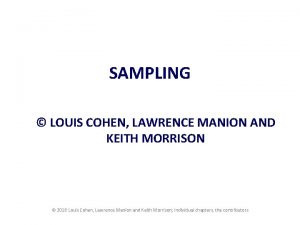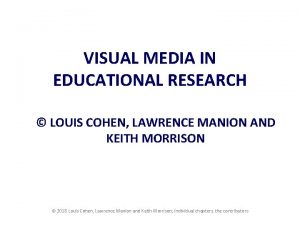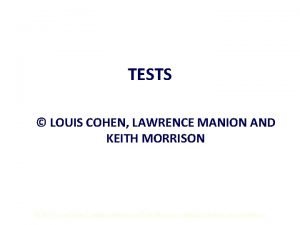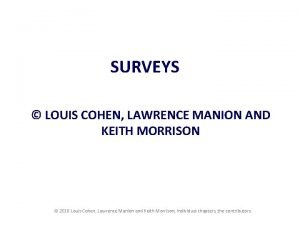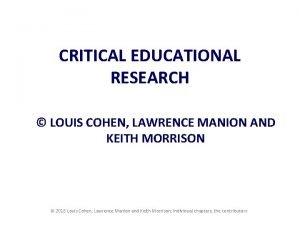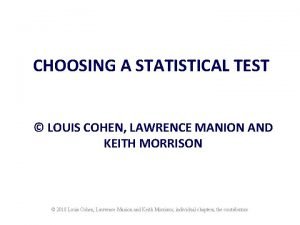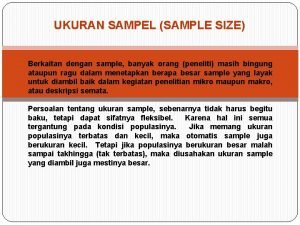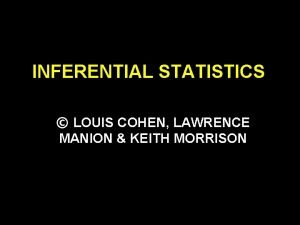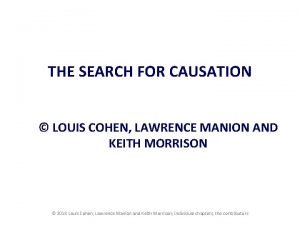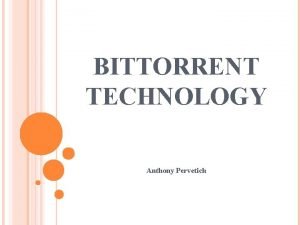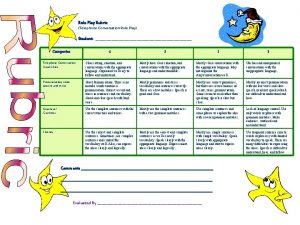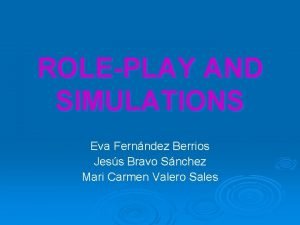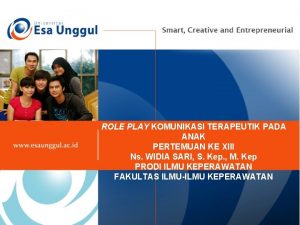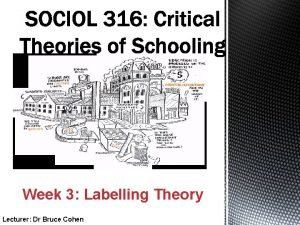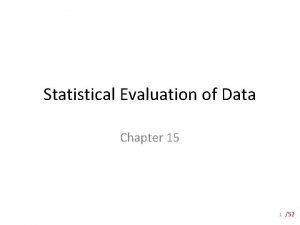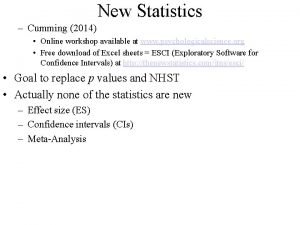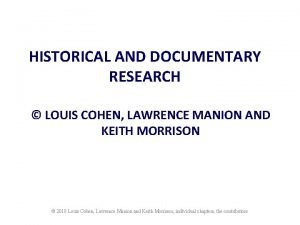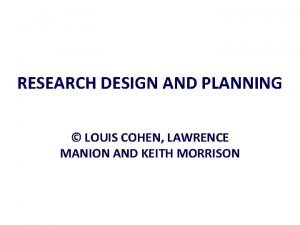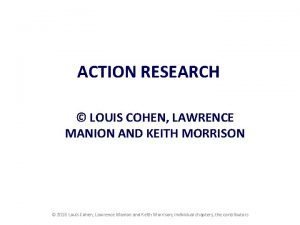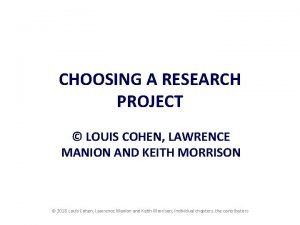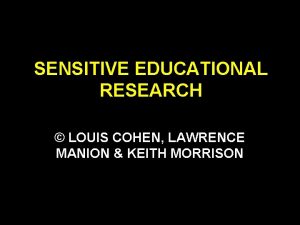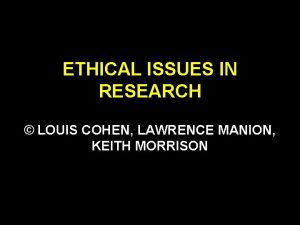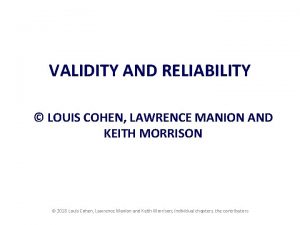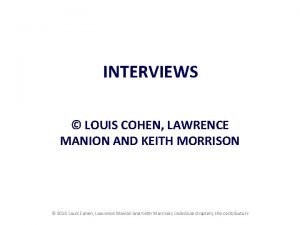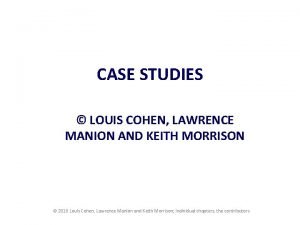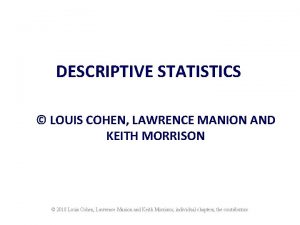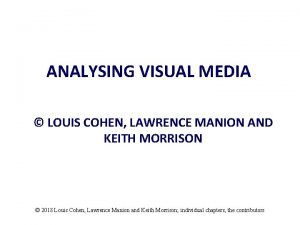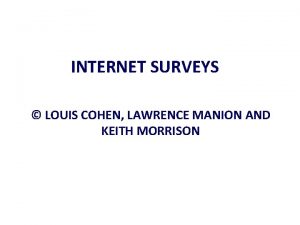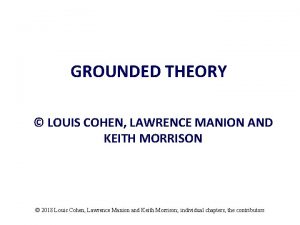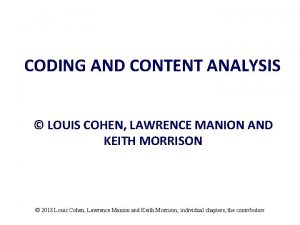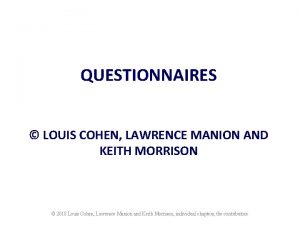ROLEPLAY AND RESEARCH LOUIS COHEN LAWRENCE MANION AND



























- Slides: 27

ROLE-PLAY AND RESEARCH © LOUIS COHEN, LAWRENCE MANION AND KEITH MORRISON

STRUCTURE OF THE CHAPTER • • Role-play pedagogy What is role-play? Issues to be aware of when using role-play Role-play as a research method How does it work? Strategies for successful role-play A note on simulations Examples of research using role-play

WHY USE ROLE-PLAY IN EDUCATIONAL RESEARCH? • Role-play is valuable for researching questions such as ‘what if’, ‘how’, ‘why’, ‘if–then’, ‘what are the effects of’, ‘what are responses to’, ‘what are the challenges in’, ‘what happens if’, ‘what are the key issues in’. • Role-play enables researchers to examine individual and group behaviour in controlled and less controlled environments, in safe environments and in particular situations. • Role-play useful in studying complex situations, interactions and evolving decisions, and in which issues capable of different interpretations, negotiations or potential conflicts are included.

ROLE-PLAY PEDAGOGY • Role-play is a way of encouraging engaged, enjoyable and deep learning from early years to adult education. • With the current emphasis on experiential learning, role-play is seen as motivational, helping to develop student confidence and facilitate graduate skills acquisition. • Places students in real-world contexts, and encourages them to explore the complexities of decision making, reflecting on issues and the views of others.

ROLE-PLAY PEDAGOGY • Role-play is increasingly being used in multiple formats: – to ‘stand in the shoes of someone else’ (role-switch: to learn from the inside out); – acting (practising a skill); and – ‘almost real life’ (experiencing something as close to the real-life example as possible). • Increase students’ sensitivity to feelings and the attitudes of others. • Enhance the authenticity of experiences. • Give students insight into the dynamics of interpersonal interactions in relationships which cannot be gained from other methods.

WHAT IS ROLE-PLAY? • A ‘spontaneous, dramatic, creative teaching strategy in which individuals overtly and consciously assume the roles of others’ (Sellers, 2002). • Role-play is an effective strategy for learning because it forces participants to think about the person whose role is being assumed, is connected to real-life situations and promotes active, personal involvement in learning. • Based on role-taking, role-making and role-negotiation: useful for accessing and exploring people’s behaviour and responses to situations and stimuli in a diverse range of contexts and settings.

WHAT IS ROLE-PLAY? Working in drama involves stepping into an imagined world, a fictional reality, and in order to make this imaginary world more meaningful and purposeful in an educational research context, it must have aspects of the real world in it. Relationships are central • between people • people and ideas • between people and the environment

THREE STAGES IN ROLE-PLAY • Briefing • Acting • Debriefing

THE EDUCATIONAL USE OF DRAMA • People involved in active role-taking, where their attitude to the situation, not their ability to portray a character, is the chief concern. • The role-play must be lived at life-rate (i. e. in that moment). • The role-play must aim to create a living picture of life, which provides a learning opportunity for the participant as much as for any onlookers, including the researcher. • Role-play is improvisational in nature and increasingly unscripted.

WHY USE ROLE-PLAY IN RESEARCH? • To help participants consider ideas from different perspectives, to think of possibilities. • To experience how people behave in particular circumstances by exploring a variety of social situations and social interactions. • To explore a range of human feelings and responses to situations. • To explore choices and moral dilemmas. • To make decisions which are tested out in the roleplay and later reflected on.

WHY USE ROLE-PLAY IN RESEARCH? • To develop a sense of responsibility and confidence as decision makers and problem solvers. • To develop personal creativity. • To improve the social health of a group and foster improved relationships with peers or colleagues. • To interact with peers and learn to compromise in order to sustain and develop activities. • To extend, enrich and prompt the use of authentic language use in simulated real-life contexts.

WHY USE ROLE-PLAY IN RESEARCH? • To explore the skills and processes involved in conflict, negotiation and resolution of difficulties and problems in their environment. • To develop agency and an increased awareness of self. • To improve visual and spatial skills through responding to a range of stimuli and situations. • Role-play operates in a ‘no-penalty zone’, where people are freer to explore and try out a range of solutions to problems and issues, without having to worry about the outcome.

ISSUES TO BE AWARE OF WHEN USING ROLE-PLAY Ethical issues • Informed consent • Overt/covert research • Non-maleficence (do no harm) and beneficence • Vulnerability and dignity of participants The researcher must act responsibly. Draw the line between illusion and reality, but make sure that there is some reality in the illusion.

CONDUCTING ROLE-PLAY • • Set the scene Narrate the dramatic frame Provide a ‘second dimension’ for each role Outline the dilemma Dramatic tension Objective of each participant Constraint Hidden objectives

ROLE-PLAY AS A RESEARCH METHOD • Explore the principles of human behaviour in real-life settings, lived at life-pace. • Access and assess how people make sense of their lives, and the structures of the natural world. • Prioritize the process of engagement. • Explore different points of view, and forge different types of knowledge. • Adopt multiple viewing points within a data set. • Study multilevel communication.

ROLE-PLAY AS A RESEARCH METHOD • Identify and explore the development and manifestation of participants’ attitudes, decisions, strategies, values, thinking skills and emotions. • Shift and alter variables as the research unfolds, to explore subtleties and nuances in human interactions and situations. • Provide planned or spontaneous prompts and stimuli to participants. • Engage with a fully diverse research population through an inclusive method to explore and access relevant data.

ROLE-PLAY AS A RESEARCH METHOD • Explore meanings and the ways in which people understand things. • Investigate patterns of behaviour. • Provide a distancing lens through which to interpret material. • Examine ready-made, visually and narratively rich research data, which evoke layers of meaning through reflection. • Capture visual data. • Involve participants as co-researchers. • Engage in meaningful interaction with participants.

HOW DOES ROLE-PLAY WORK? • Brief participants on: • • the purpose of taking on the role; the status or level of power of the role; the attitude of the role; the participant’s motivation in the role-play. • A loosely structured role-play places more demands on participants, and thus requires greater preparation. • The effectiveness of role-play is dependent on careful planning and the educator’s ability to convey confidence to participants that role-play can be a valuable strategy.

IMPORTANT STRATEGIES FOR SUCCESSFUL ROLE-PLAY • Inserting dramatic tension and awakening participants’ self-spectator. • Protection into (not ‘from’) role and protection into emotion. • Ensure adequate preparation. • Attention to detail and practicalities. • Careful debriefing.

DEBRIEFING • What are the purposes of the debriefing (and tell participants)? • What points must be addressed? • What questions can be posed (e. g. to promote discussion and feedback)? • What feedback must, should and may be given, and about what? • What data the researchers wish to collect. • What and how to summarize. • How to involve and receive feedback from observers (if there were any).

DEBRIEFING • How to manage the debriefing: – What are the ground rules, e. g. : the Chair nominates or identifies the speaker (or places several volunteer speakers in a sequence)? – Nobody interrupts a speaker; – Speakers are polite and respectful, even when raising points of criticism; – Nobody may speak for more than three or four minutes; – Each speaker must keep to the point, i. e. avoid redundant or irrelevant material; – Each speaker should build on, or link to, the previous speaker where possible.

DEBRIEFING • How to affirm participants and be positive about comments received. • How to promote participation in the debriefing. • How and when to give feedback from observers/experts. • How to open, continue and conclude the debriefing.

SIMULATIONS • Educational simulations involve a sequence of events which typically involve or lead to decision making, and in which the environment or situation is set up by the researcher. • Participants take on roles and the sequence of activities evolves, sometimes planned and sometimes unplanned, as the simulation rolls out over time. • Simulations often involve problems and many differences between participants, e. g. in terms of attitudes, agendas, perceptions, powers, voice, status, values, sympathies and agendas, i. e. in which the potential for conflict or disagreement features strongly.

SIMULATIONS Simulations are designed to put participants in a realistic representation of a situation, environment and issue, recognizing and building in the complexities of these, within which interactions should occur, leading to an outcome (e. g. a decision, a compromise, an action, a statement, a change of view).

SIMULATIONS Researchers must ensure that the scenario design has the hallmarks of realism (e. g. situational, physical, emotional, conceptual, interpersonal), i. e. that it could really happen in the ‘real world’, and that participants understand the situation and what is required of them.

CHOOSING A TOPIC FOR A SIMULATION • Select a topic that is interesting, topical, realworld, relevant and engaging. • Select a topic that will enable different perspectives, interest groups (maybe conflicting interests) and agendas to be included. • Select a topic that will enable different groups of participants to take on the roles/interests/agendas of these different groups.

CHOOSING A TOPIC FOR A SIMULATION • Take a controversial issue, an issue on which there is dissensus and maybe strong feeling, a conflict or problematic situation, one that is not susceptible to simple solutions, or one in which there are different interests at play. • Take an issue on which there are many perspectives, differences of opinion, and then construct a scenario around this. • Focus on a crisis situation, or a sensitive, delicate matter, or a situation in which there is no single or correct answer.
 Cohen manion and morrison 2018
Cohen manion and morrison 2018 Ex post facto study example
Ex post facto study example Cohen manion and morrison 2018
Cohen manion and morrison 2018 Cohen manion & morrison 2018
Cohen manion & morrison 2018 Cohen manion and morrison
Cohen manion and morrison Lawrence manion
Lawrence manion Lawrence manion
Lawrence manion N = z2pq/d2
N = z2pq/d2 Levene's test for equality of variances
Levene's test for equality of variances Lawrence manion
Lawrence manion Bram cohen jenna cohen
Bram cohen jenna cohen Rubrics in role playing
Rubrics in role playing Deca role play rubric
Deca role play rubric Deca instructional areas
Deca instructional areas Bravo roleplay
Bravo roleplay Role play komunikasi terapeutik pada remaja
Role play komunikasi terapeutik pada remaja Dr bruce cohen st louis mo
Dr bruce cohen st louis mo Louis vuitton history timeline
Louis vuitton history timeline Aiden cohen
Aiden cohen Widows peak perio
Widows peak perio Cohen sutherland line clipping algorithm example
Cohen sutherland line clipping algorithm example Medium effect size
Medium effect size Cohen's d effect size criteria
Cohen's d effect size criteria Taya cohen
Taya cohen Cohen's d formula
Cohen's d formula Alan cohen neurosurgery
Alan cohen neurosurgery Neurohistoria
Neurohistoria Cohen's f
Cohen's f
